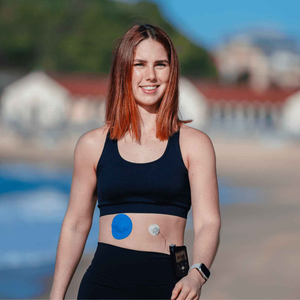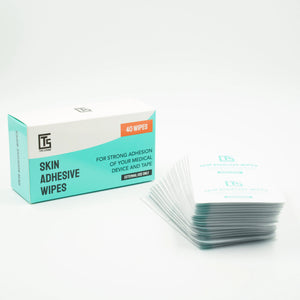Keeping your CGM safe can be tough at the best of times. Add something like swimming or exercise to the mix and it can be game over. CGM’s are amazing technology that can really help improve the quality of life for people living with diabetes. However, the technology is still very expensive – especially when you consider the multitude of other diabetes related expenses in your life.
In this blog, we have put together a quick guide to help you keep your CGM safe and sound so that you can enjoy all of your favourite activities, without worrying about your sensor.
Skin prep
Preparing your skin correctly before applying your CGM is the most important piece of the puzzle. To ensure a strong adhesion between the CGM and your skin, your skin must be clean from dirt and oil, and completely dry.
Generally, it is best practise to clean the application area with an alcohol wipe to remove any dirt and oil from the skin’s surface. Give the area 30 seconds to dry and then apply your CGM.
If you have recently swam or showered, it is best to wait 30 minutes (or longer) to allow your skin to completely dry. If you have body hair on the area in which you would like to apply your CGM, it is recommended that you shave this area before application.
Select the best location for you and your CGM
Selecting the right part of your body can help limit the number of times you risk knocking your sensor. Although most CGM’s are recommended for specific locations, there is often some leeway in which you can choose the best location. For example, the Freestyle Libre is only approved to be worn on the back of the upper arm (learn how to use and apply FreeStyle Libre here). However, if you are to place your sensor more towards the back or inside of your arm rather than the outside, you are much less likely to bump it on doorways and other things of that nature.
This same thinking can be applied to other CGM’s such as the Dexcom and Medtronic Guardian. Many Dexcom users have a personal preference between their abdomen and upper arm, while many Medtronic users opt to place the sensor on their leg as it is often covered and safe from knocks.
Follow the instructions when applying your sensor
It may sound obvious, but it is important to read the manufacturer’s instructions before applying your CGM. Often there are some small details that can have a large effect on the effectiveness of your CGM.
For example, with the Dexcom G6, placing the device on your selected location and pressing the button seems simple, but cleaning the site and rubbing down the white, adhesive parts are sometimes ignored.
Another example is the Freestyle Libre; it is officially recommended not to place the sensor on areas with moles, stretch marks, scars or lumps, and always select a site that is at least an inch away from an insulin injection site.
Please take the time to read the manufacturer’s instructions (at least once) and you may find some key details that will help you keep your CGM safe.
But my CGM still won’t stay ‘stuck’?
The above tips about correct skin prep, choosing the right location, and following the instructions will work for some people. However, many people may still experience issues with adhesiveness and would like some extra security for their CGM. For these people there are two main options, skin adhesion promoters like tackifiers and CGM adhesive patches. These options can be used individually or together for maximum effectiveness.
Tackifiers are chemical compounds used to make adhesives. They increase the tack or stickiness of the surface, which in this case is your skin. Diabetes QLD recommends Matisol Liquid Adhesive, IV Prep, Cavilon Barrier or Convacare Barrier Wipes to enhance the adherence of CGM sensors to the skin. Make sure you always apply these in a doughnut form, leaving a hole in the middle for the sensor needles.
CGM adhesive patches provide the best protection for people who simply don’t want to worry about losing a CGM sensor. Type Strong manufactures adhesive patches for Freestyle Libre, Medtronic Guardian, Omnipod and Dexcom CGM’s. Our patches last 10+ days, are easy to apply, and they are hypoallergenic (meaning they are kind to even the most sensitive skin). Check them out here.
My skin reacts to CGM adhesives…
All the tips that we’ve mentioned above will no doubt keep your CGM safe… but what about issues with skin reactions?
Skin irritation and allergies are serious problems and cannot be ignored. If you have very sensitive skin that reacts to the adhesive of CGM’s, try using topical corticosteroid creams to reduce itchiness and inflammation of the skin. These creams have been approved by 77% of CGM users. Barrier films are also sometimes recommended to protect the skin from adhesive related reactions. These thin patches are applied under the sensor leaving a hole in the middle where the sensor filament or cannula penetrates the skin. Some of the barrier films currently available are OpSite Flexifix, IV3000, Tegaderm and HP Film.
Please keep in mind that everyone’s skin type is different, so it is best to stick to a trial-and-error method to find what is most suitable for you and your skin type. Once you find the right products and the most suitable routine, you will notice a significant improvement in the duration of use and tolerability of your skin to the CGM adhesive.
Wrapping Up
Ready to enhance your CGM experience? Secure it with confidence using Type Strong CGM Adhesive Patches. Our hypoallergenic patches offer 10+ days of worry-free wear, ensuring your CGM stays firmly in place. Say goodbye to concerns about adhesion and skin irritations. Explore the reliability of Type Strong patches and make your CGM journey smoother. Your active life deserves the best support, choose Type Strong today!
|
We hope that this blog provides you with some good tips on how to keep your CGM sensors safe and secure. If you have any questions or would like more information on our CGM patches, please feel free to reach out to us at hello@type-strong.com. Disclaimer: The information presented on this blog is provided for general informational purposes only. It is not intended as a substitute for professional medical advice, diagnosis, or treatment. Reliance on any information provided by this blog is at your own risk, and we strongly recommend consulting with a qualified healthcare professional for individualised advice regarding your specific situation. In addition, this blog may contain links to external sites or feature content from third parties. Please be aware that we do not undertake investigations or monitoring of these external links for accuracy, adequacy, validity, reliability, availability, or completeness. Consequently, we disclaim any liability or responsibility for the information contained therein. Users are encouraged to exercise their own judgement and discretion when accessing external content linked from this blog. |





